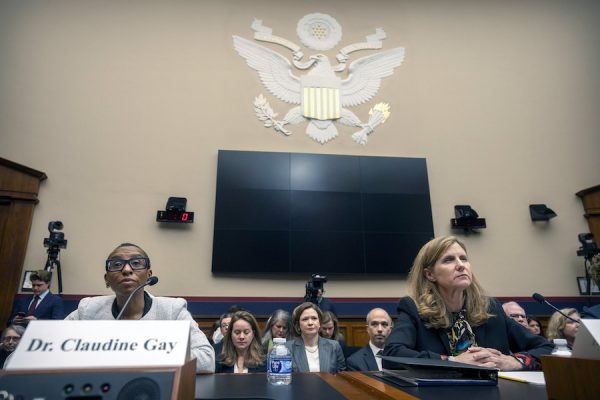When Donald Trump signed the spending bill two weeks ago, he did so reluctantly. The bill did not include funding for his much-promised border wall, an oversight he said made him consider vetoing it. Yet, in the end, the $1.3 trillion spending bill was palatable to him because it did include a $1.6 billion increase to border security funding—money that will mostly go toward increased surveillance technology.
Most Americans probably do not think much about these technologies, but they have been increasingly a reality of life at the border since 9/11, when Customs and Border Protection (CBP) was folded into the newly created Department of Homeland Security (DHS). Border security used to be about undocumented immigration and drug smuggling. Now the border is a central theater of national security. But blurring the distinction between home and abroad does not erase the border—quite the opposite, it expands it.
We might think of the border as a kind of colonial project. It not only functions to keep people out, it also demands the loyalty of the border community itself.
In 2012, as part of my field research on the United States–Mexico border, I attended a border security expo in Phoenix, Arizona, to see these technologies for myself. It was there I learned that border security is as much a culture as it is an institution.
The expo was a sort of bazaar; the people, sales evangelists driven by zealous patriotism and a healthy amount of testosterone. One took me into a makeshift control room, assembled in the giant hall, and showed me the feed from a camera positioned at the Texas border, opposite the Mexican city of Juarez. The telephoto lens was so powerful it could focus on a pair of panties hung out to dry seven miles from the border. Another was hawking a new form of airport body scanner that, if tweaked properly, could detail the contours of a person’s nipples.
One of the funders of the expo was Lockheed Martin, which had a giant display of combat weapons. They ran a raffle where, if you deposited your business card, you could win a cutting-edge handgun, and the weapon was put on display so that anyone who came by could feel its trigger against their fingertips and imagine its place in their collection.
Running alongside the expo was a conference, a series of rooms filled with participants from DHS, CBP, and Immigration and Customs Enforcement (ICE), as well as local sheriffs and border-county mayors. Their goal was to discuss the future of border security, but it often felt like a wish list for their desired technologies. The officials would state what they were looking for, holes they needed filling, or more pie-in-the-sky desires, and the audience, which was mostly comprised of industry professionals, would take notes, ask questions, or pitch products to get the panelists’ reactions. In the back was a smattering of journalists, mostly local, and some researchers, including me.
It was at these meetings that I started to see the border differently, to see it as the state sees it. From the perspective of its agents, border security should be a “layered detection system,” a “net.” As one official expressed it, “The wider we make our borders . . . the more effective we are going to be.” Their aim is not simply to erect a static, soaring barrier fifty feet above the border, but to extend the border’s “horizontal footprint” inland.
This understanding helped make sense of some of the technologies I encountered at the expo—indeed, some of the technologies Trump’s new bill is so eager to fund. For example, some stalls sold ground sensors (seismic, magnetic, infrared) that could be deployed throughout the border region, extending many miles inland. If they registered movement—“sensor hits”—the border patrol would immediately be notified. Another company offered perimeter fencing with “buried cable detection systems” that would create an invisible sensor field beneath the earth—essentially the surveillance version of landmines.
Other technologies included cameras and radars attached to unmanned aerial vehicles, which create a “visual net” and can be controlled remotely, serving as “the eyes” of agents. Following the same logic as sensors, these systems could work alongside covert cameras—disguised as rocks, for example—scattered throughout the borderlands region.
Citizens at the border are empowered to be police. There are now smartphone apps that let them communicate directly with federal officers—as tech-enabled ‘first responders.’
Currently the most visible component of the inland “net”—and the aspect that has drawn the most public ire—is the checkpoints, or “chokepoints.” These are unique legal spaces in which guards do not need probable cause to pull people over. Similarly, they are “contact points” where agents can capture biometrics (usually fingerprints or irises). This reflects a new mission of the Border Patrol, which is to “identify, not just catch.” It follows procedures pioneered by the military, with units in Iraq and Afghanistan capturing fingerprints and relaying that data via satellite to see if the person is on a terrorism watch list. While touring a detention facility in El Paso, a guard told me that detainees are so scared of these new biometric identification tactics that they often scrape their hands against the walls to rip the patterning off their fingertips.
But besides just inspiring fear, these technologies have a different type of functionality than a wall. They are covert, aimed at detection, not deterrence. Their aim is to expand the border rather than define it.
This change has not been lost on the people who live in the borderlands. Once, when I interrupted an interview for a pit stop at a roadside McDonald’s, I was warned, jokingly, “Don’t do anything suspicious in there. That’s the most videoed McDonald’s in the world.” Borderlands residents try to keep up their humor in light of the security state they live in. But it is rarely a laughing matter. For example, some citizens of Arivaca, Arizona, have been protesting for years about the civil liberty violations caused by the checkpoint outside their town. Protest signs have read, “Check yourself BP, stop watching our community,” and “Our communities are not your warzones.”
From the vantage of the state, these new policies are sensible. But in practice the bustle of governmental activity at the border (from federal, state, local, and sometimes even military actors) can feel like chaos. ICE has recently ratcheted up the detention of undocumented immigrants. A 1953 Department of Justice regulation defines their dominion as extending 100 miles from any border (this rule counts all coastal regions as borders, as well)—a swath of land that now encompasses more than 200 million Americans (about 2/3 of the population). ICE agents are not supposed to pull people over without “reasonable suspicion,” but in videos, spread virally on social media, ICE officers pull passengers off buses seemingly at whim. Concerns about ICE will only expand if it joins the intelligence community and thus gains access to tools of international espionage. This would allow ICE to conduct warrantless surveillance over U.S. citizens.
These issues grab our attention in part because they affect people nationwide. But in treating the national side of the debate, it is easy to forget about the people that live directly on the border itself. The demands of security are steep, and increasingly U.S. citizens are implicated. Once you look at borders through the eyes of the state, so many things come into relief. Regardless of whether local citizens are protected by the wall, without question they are caught in the net.
• • •
Today we are all to some degree watched by the state. But for most of us, this is something innocuous, unnoticed. We have a hard time imagining what it would be like to live in the borderlands, where the state is everywhere, and everywhere watching. And where, perhaps worst of all, citizens increasingly submit to doing the watching themselves.
These issues are not lost on many sectors of U.S. society—blacks, immigrants, the poor—who have often felt state scrutiny overwhelmingly focused on them. But there is also something special about the conditions of the borderlands, in part due to the nature of rule. There is a blurring of security and defense functions, between inside/outside.
The border is a central theater of national security. It is not merely a barrier or a wall, it is a net that spreads inland.
Inasmuch as borderlands are places of law enforcement, they are also spaces of vigilance—where citizens are empowered to, in some sense, be police. For most of us, this logic of community vigilance is familiar. After all, who has not seen the DHS slogan “If You See Something, Say Something”? But at the border this commitment is totalizing, rather than conditional. There are now smartphone apps that let citizens communicate directly with federal officers—as tech-enabled “first responders.” As one industry entrepreneur explained it, “notification systems are now becoming two-way,” from citizens to law enforcement and back again.
Such is DHS’s vision: the central state integrating into its periphery and local communities helping enforce the law. After all, who has better knowledge of the local community than the people who live in it? There are now official Border Patrol liaisons with community leaders, and programs designed to foster “community and stakeholder outreach.”
Notable amongst these is the CBP Explorer’s program, which is integrated into the Boy Scouts of America as its highest division, and invites high school students—boys and girls as young as 14—to learn to be the next “guardians” of “America’s frontline.” The students receive firearms training and engage in threat simulations, in which they chase border crossers and negotiate hostage situations. The education is designed to recruit and train future border agents. But it also indoctrinates the students in the logic of bordering: that the aim is to let the good guys in and keep the bad guys out, and that border control starts with engaged citizens.
That borders are areas of dense federal engagement and citizen-making activity may be surprising for some readers, but it should not be. Indeed, the original challenge of statehood was to achieve homogenization within, not merely to negate the world without. In the United States, people of Mexican decent throughout the borderlands—many with roots on U.S. soil for six or seven generations—embody this concern. For them, the proud refrain is, “We never crossed the border, the border crossed us.” These people are patriotic Americans. But for the state, they also carry within them the possibility of being something else. Thus they are a people whose loyalty must be monitored and maintained. This helps explain some of the moves described above, such as local education campaigns, the relocation of federal authority at the periphery, and of course the “net” of personnel and infrastructure that expands inland from the border. The borderlands are a space in which the state not only watches its subjects, but shapes them.
The practice of centers taking control over their peripheries is as old as states, but it is not innocuous. When the federal government takes control of its periphery, it imposes a kind of alien rule, even on the familiar terrain of the homeland. What we miss, when we focus only on the outward face of the border—the wall we build to defend against the barbarians outside—is the function that state projections of power have internally. What is the point of ostentatious displays of power at the state’s edge—not just the wall, but flags, uniforms, songs and other performances of national identity that have, in the United States, become evermore dramatic after 9/11? Of course they are there to warn off potential transgressors. But they are also there to guarantee the loyalty of the border community itself—to remind the people inside the border who they really are. It is a kind of domestication: a domesticating of what has the potential to become foreign.
In this sense, we might think about the border as a kind of local colonial project. Border policies and ceremonies are as much designed to remind locals of who they are as it is to tell outsiders who they are not. The border fences in as much as it fences out. Peripheral peoples are not trusted and so they are disciplined. They have a double role: they are on the one hand most at risk from outside threats, as well as at risk of becoming a threat. Peripheral peoples are at once the subject of security, and its object.
This problem is not new. In ancient Rome, the frontiers were filled with dubiously loyal subjects, many attempting to avoid taxation, so authorities took great pains to cultivate their loyalty. Indeed, one function of early walling systems was to divide the barbarians outside from those—also barbarians—who were in the process of being incorporated into Rome. The Great Wall of China was similarly designed to keep imperial subjects from escaping. In the British and French maritime empires, metropolitan subjects were sent out into the newly colonized lands to inculcate loyalty to the center.
New technologies of surveillance include a telephoto lens so powerful it can focus on panties hung out to dry seven miles from the border, and an airport body scanner that can detail the contours of a person’s nipples.
Early modern states behaved the same way, with elaborate ceremonies to delineate the border, frequently including visits by kings and lavish displays of wealth. The point was not simply to generate loyalty in subjects, but to suggest to distant peoples who they should be loyal to. In the nineteenth century, states embraced nationalism for the same purpose—fostering identification with the center, while extinguishing linguistic and religious heterogeneity—and we still see the vestiges of those efforts today.
When we think of walling, we think about external security. The wall is part of a fantasy of exclusion, of defense, of impenetrability. But new border security policies aim to perfect the control over the internal subject as well—fantasies of entrapment and domestication. It is the subjugation of citizens who embody not the threat to invade, but to secede.
To some degree, security presence in the borderlands is expected. But it is also unsettling. The border has become less a site of authority than it is one of anxiety. We might thus ask not merely how much security is too much, but another, more challenging question: what is it about this security that we find objectionable? The security we see in the borderlands is also aimed at our own citizens, and so there is a displacement of burden: the security of the nation rests disproportionately on the backs of borderlands dwellers—and this is not necessarily of their choosing. It is security aimed as much at their protection as it is at their control.
• • •
Cast in this light, it is hard to think of our debate over Trump and his wall as anything but a distraction. National debate about border security and common practices is minimal, but it is important for us not to lose sight of the big picture: that walling is at most a tiny part of bordering, and on its own it is ineffective. It cannot replace manpower and ever-more-complex technology. It also cannot replace political solutions that create the environment in which borders exist. Borders are brick-and-mortar places, but they are also people-and-policy places. The one cannot replace the other, no matter how much money we spend.
So what do we do? Would it be possible to imagine a more progressive arrangement for people in the borderlands? I remain hopeful. But the path ahead must begin with identifying the harms that new forms of border security mete out upon the people that live in their midst. Once we do this, we can start to build up protections. This starts with a more expansive debate in civil liberties communities about where state capacities end and citizens’ rights begin.
It also requires a debate in political communities. We owe borderlands citizens a greater role in the decision-making process about border policies. Peripheral peoples are frequently the least represented in these matters, as security policies remain driven by votes from citizens hundreds of miles from the border, frequently against the wishes of the border dwellers themselves. Given the challenges of life in the periphery, cultivating a healthy, empowered borderlands population should be a priority, not an afterthought.








